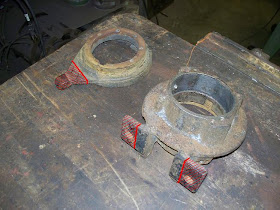 I was able to visit the Monticello Railroad Museum over the weekend, while staying with in-laws. This museum has been very successful over the past few years, although it is not near any large population centers. When I visited, they were getting ready to run their popular North Pole Express trains, which are operated under license from the publishers.
I was able to visit the Monticello Railroad Museum over the weekend, while staying with in-laws. This museum has been very successful over the past few years, although it is not near any large population centers. When I visited, they were getting ready to run their popular North Pole Express trains, which are operated under license from the publishers. The museum's site is located along an Illinois Terminal right-of-way. During the 70's, new track was laid for a couple of miles on the IT alignment, but the museum was able to acquire the paralleling IC branch when it was abandoned, and now operates on the IC tracks into downtown Monticello. This is the depot in Monticello, with some Christmas decorations. It's about three miles from here to the museum site.
The museum's site is located along an Illinois Terminal right-of-way. During the 70's, new track was laid for a couple of miles on the IT alignment, but the museum was able to acquire the paralleling IC branch when it was abandoned, and now operates on the IC tracks into downtown Monticello. This is the depot in Monticello, with some Christmas decorations. It's about three miles from here to the museum site. Old #1, an 0-4-0T is now on display by the access road to the museum. Back in the 70's this was the usual service locomotive, while missing its tank and pulling a tender larger than itself.
Old #1, an 0-4-0T is now on display by the access road to the museum. Back in the 70's this was the usual service locomotive, while missing its tank and pulling a tender larger than itself.  The 191 was also operable, and we ran double-headers occasionally.
The 191 was also operable, and we ran double-headers occasionally.The biggest current project is restoration of Southern Railway 2-8-0 #401, with a new boiler. See the steam page here for details.



This roof over the display cars is new.
 Here are some more decorations.
Here are some more decorations. Here's a link to their website, and my thanks to Kent McClure, CMO, for taking time out of his busy schedule to show me around.
Here's a link to their website, and my thanks to Kent McClure, CMO, for taking time out of his busy schedule to show me around.











































